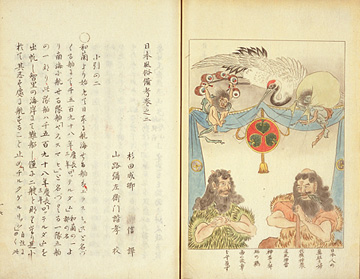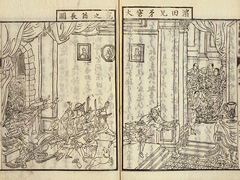Home | Part 1: Tracing the History | 1. Beginning of Exchange between Japan and the Netherlands
Part 1: Tracing the History
This online gallery selects major themes from exchanges between Japan and the Netherlands during the Edo period (1603 to 1867), and uses relevant materials owned by the National Diet Library to introduce these themes in Part II. This section presents an overview of the history of this exchange to give visitors an overall feel for exchanges between Japan and the Netherlands.
1. Beginning of Exchange between Japan and the Netherlands
(1) Stranding of de Liefde in Japan
The 400 years of exchange between Japan and the Netherlands began in 1600. In April of that year one foreign ship ran aground on the coast of Usuki in Bungo Province (now Usuki City, Oita Prefecture). The ship was de Liefde and was the first Dutch ship to reach Japan. Five ships including de Liefde set sail from Rotterdam for the East in June 1598. The fleet followed a course that took it through the Strait of Magellan and then on to the Pacific, but after storms and attacks from Spanish and Portuguese ships only de Liefde reached the Far East. The few remaining survivors included Captain J. Quaeckernaeck, Officer Jan Joosten van Lodensteyn, and English ship's pilot William Adams. These men were summoned to Osaka on the orders of Tokugawa Ieyasu, who ruled the country, and then who consulted them for their knowledge. Jan Joosten van Lodensteyn was granted a vermilion-seal certificate and was an active trader, and the area he lived in Edo came to be called Yaesu-gashi after him. William Adams gained the confidence of Ieyasu and served him as a foreign affairs advisor. He was given the Japanese name Miura Anjin because he was granted a small fief on Miura Peninsula and he was a ship's pilot (Anjin means "ship's pilot").
(2) Trade Permission for the Dutch and Establishment of Hirado Factory
At the time, most trade with Japan was done by the Portuguese. Ieyasu granted a 'red-seal' pass, which permitted trade with Japan, to J. Quaeckernaeck to create a counterforce to the Portuguese. In response a Dutch East India Company (Vereenigde Oost-Indische Compagnie or VOC) ship docked at Hirado in Kyushu in 1609 and brought a personal letter and gifts from Prince Maurice of Nassau for Ieyasu. Ieyasu received the emissary to Sunpu and consigned a letter and a red-seal pass granting trading rights. This prompted the establishment of a Dutch factory at Hirado and trade between Japan and the Netherlands started.
The Netherlands at the time was an emerging nation that had recently declared its independence in 1581 after a rebellion against Spain started in 1568 by Protestants. The Netherlands was no longer able to rely on Spanish ships for trade and so actively engaged in maritime pursuits to establish commercial viability. The VOC was established in 1602 through the merger of several trading companies and was given by the government a trading monopoly for areas east of the Cape of Good Hope and broad authority to form agreements with foreign countries. The company established headquarters at Batavia (now Jakarta) on the island of Java where the Governor-General of East India resided. The factory in Japan was also under the jurisdiction of the Governor-General.
(3) The Nuyts Affair
Initially, Japanese-Dutch trade was unrestricted but after 1616 all foreign ships except those from China were restricted to docking at either Hirado or Nagasaki, and even this was interrupted temporarily due to a trade dispute.
In 1622, the Netherlands built a factory and fortress (Fort Zeelandia) as a base in Formosa (Taiwan) to compete with Spain and Portugal for raw silk from China. A dispute arose between Japanese and Dutch merchants seeking local exclusive trading rights and the Batavian government assigned Governor of Formosa P. Nuyts stationed in Formosa to resolve it. In 1628, P. Nuyts fought a battle against Captain Hamada Yahyoe of a ship licensed by a red-seal pass, who took several Dutchmen as prisoners and returned to Japan. At the request of Captain Hamada's group, all trade with the Netherlands was terminated, and P. Nuyts was handed over to Japan as the person responsible and was imprisoned in exchange for the captives (he was released in 1636). This resolved the issue and trade was reopened in 1633. In appreciation for permission to trade, the chief of the Dutch factory was required to regularly journey to Edo to present himself at court.
Navigation
-

-
Beginning of Exchange
between Japan and the
Netherlands - Dutch Factory on Deshima
- Boom in Dutch Studies
-
Opening of Japan and
Japan-Netherlands
Relation - Columns
-
Beginning of Exchange
-

Copyright © 2009 National Diet Library. Japan. All Rights Reserved


